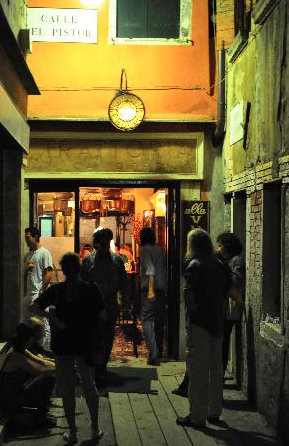.
The DOGES PALACE / SAINT MARKS BASILICA
In WINTER
VENICE , ITALY
.
.
SAINT MARKS BASILICA
PIAZZA SAN MARCO
VENICE
2003
Grand Canal
VENICE
Italian Cookbook Author Daniel Bellino Zwicke
1995
The DOGE'S PALACE
PIAZETTA at PIAZZA SAN MARCO
VENICE
NEED a HOTEL in VENICE
.
PEGGY GUGENHEIM MUSEUM
The GRAND CANAL
DELLA SAULTE
VENICE
Taken from a MOTOSCAFI
.
.
.
CAFFE FLORIAN
PIAZZA SAN MARCO
VENICE
CAMPARI & OJ
FRANK MYSELF and COUSIN TONY
.
.
Me and Cousin Joe
PROSECCO at a BACARO
VENICE
Author Daniel Bellino-Zwicke
.
Harry's Bar
.
The WORLD'S COOLEST RESTAURANT
.
ARIGO CIPRIANI
Son of GIUSEPPE
aka HARRY
,
ERNEST HEMINGWAY at HARRY'S BAR
with Owner / Founder GIUSEPPE CIPRIANI
HARRY'S BAR was one of HEMINGWAY'S Favorites
"Me Too" !
.
POSITANO The AMALFI COAST
TRAVEL GUIDE / COOKBOOK
.
The BRIDGE of SIGHS
VENICE
The HOTEL DANIELI
VENICE
MANGIA ITALIANO
MEMORIES of ITALIAN FOOD
Daniel Bellino Zwicke
.
HOTEL FIRENZE
My FIRST VENETIAN HOTEL
June 1985
.
.
My HOTEL ROOM
HOTEL FIRENZE
VENICE
.
.
.
.
MAP of VENICE
HOTEL FIRENZE
.
I got lost in VENICE at Night. It was my first night there and my first trip ever to Europe. I was a young man of 23 and relatively new in my travel experience, how to get around and what to do. Yes I got lost and the Magical Maze, The Labyrinth that is Venice, with its winding streets, many bridges and narrow alleyways.
I learned a very important travel lesson that night. One of the first things you should ever do as you are in a new city and check into your hotel. While you're at the desk, make sure to take a couple Business Cards of the hotel. Put one in your wallet or purse immediately, and put another in one of your pockets. If you ever get lost, you can give it to a Taxi Driver (Not in Venice though) and tell him to go here.
Yes, I got lost in Venice. I didn't feel it at the time, but it's a quite Wonderful thing to do, getting Lost in Venice.
.
Hotel Guerrato
VENICE
1995
HOTEL GUERRATO
.
The BREAKFAST ROOM
HOTEL GUERRATO
.
My Room
Hotel Guerrato
VENICE
I found this wonderful little Hotel in 1995, on my special trip to Explore the BACARI (Venetian Wine Bars) of VENICE. I had read a tiny little article about them in the New York Times that peeked my interest and inspired me to open one in New York. I book a trip for 8 days in Venice to explore, feel, experience and find out everything I could about the Wine Bars of Venice (Bacari). And I did just that. With the knowledge of that trip and my many years experience in the restaurant business in New York, I made a business plan, found a partner to join me, and I created the First Ever Bacaro in The United States, called BAR CICHETTI in New York's Greenwich Village. Basta !
.
SAN GIACOMO
The OLDEST CHURCH in VENICE
Built 1071
At The RIALTO
If You stay at GUERRATO
This is just 200 Feet Away
.
The RIALTO MARKET
Over 700 Years Old
If you stay at Albergo Guerrato, you are Literally Several Feet from The RIALTO
You walk out the Door of the hotel, make a right, walk 30 Feet and you are Inside The RIALTO MARKET. It doesn't get much Better than that.
FRUIT MARKET
The RIALTO MARKET
VENICE
BAR CICHETTI
America's FIRST Ever VENETIAN WINE BAR
aka BACRO
Created by Daniel Bellino-Zwicke
and Tom Taraci
.
A Motoscafo Passes Through
PONTE ACCADAMIA
VENICE
View from Accadamia Bridge
TURNER
TURNER
HOTELS in VENICE
And WORLDWIDE
BOOKS by DANIEL BELLINO Z
.
DORSODORO
VENICE
1995
The BREAKFAST ROOM
TIVOLI
VENICE
My Room
The HOTEL TIVOLI
VENICE
HOTEL IRIS
VENICE
Stayed Here in 1996
.
View from My Room
HOTEL IRIS
VENICE
VENICE HOTELS
ALL ITALY
And WORLDWIDE
.
PALAZZO DARIO
VENICEITALY
Near HOTEL IRIS
DORSODORO
VENICE
.
SUNDAY SAUCE
When Italians Cook
.
CAFFE FLORIAN
.
.
GIACOMO CASANOVA
.
CASANOVA Seduces
.
Trattoria Poste Vecie
Since 1500
This restaurant was a Favorite of GIACOMO CASANOVA
.
.
Where CASANOVA Often DINED
and SEDUCED
In the fish market area, in Campo delle Beccarie, there is instead Poste Vecie restaurant open since 1500, where Casanova used to hide away with friends and especially girl friends to enjoy luxurious banquets. The whole area of St. Mark’s Square and especially the old premises, starting from Caffè Florian, have been hunting grounds of the great seducer.
DO MORI
The erotic tour of Venice cannot exclude the Rialto area and in particular the Sotoportego dei Do Mori where in the tavern of the same name Casanova liked giving the first appointment to his ladies. Who showed up strictly masked.
.
.
Antonio Vivaldi
.
.
See a VIVALDI CONCERT at The PIETA
Where VIVALDI was The MAESTRO
.
The PIETA
On The RIVA DEGLI SCHIAVONA
VENICE , ITALY
.
.
The RIVA DEGLI SCHIAVONI
by CANALETTO
.
.
BACARI
The WINE BARS of VENICE
VEDOVA
.
.
INSIDE The BAR at VEDOVA
BACARO
.
GONDOLA'S with Della SALUTE in Background
The MOLO
VENICE
.
The RAGU BOLOGNESE COOKBOOK
The WORLD'S TASTIEST DISH
SECRET RECIPE
.
.
.
The ITALIAN NATIONAL TEAM
"AZZURI"




